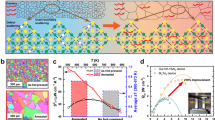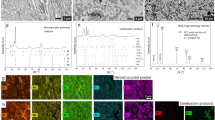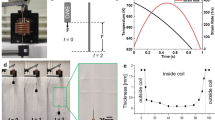Abstract
Most materials expand upon heating. Although rare, some materials expand on cooling, and are said to exhibit negative thermal expansion (NTE); but the property is exhibited in only one crystallographic direction. Such materials include silicon and germanium1 at very low temperature (<100 K) and, at room temperature, glasses in the titania–silica family2, Kevlar, carbon fibres, anisotropic Invar Fe-Ni alloys3, ZrW2O3 (ref. 4) and certain molecular networks5. NTE materials can be combined with materials demonstrating a positive thermal expansion coefficient to fabricate composites exhibiting an overall zero thermal expansion (ZTE). ZTE materials are useful because they do not undergo thermal shock on rapid heating or cooling. The need for such composites could be avoided if ZTE materials were available in a pure form. Here we show that an electrically conductive intermetallic compound, YbGaGe, can exhibit nearly ZTE—that is, negligible volume change between 100 and 400 K. We suggest that this response is due to a temperature-induced valence transition in the Yb atoms. ZTE materials are desirable to prevent or reduce resulting strain or internal stresses in systems subject to large temperature fluctuations, such as in space applications and thermomechanical actuators.
This is a preview of subscription content, access via your institution
Access options
Subscribe to this journal
Receive 51 print issues and online access
$199.00 per year
only $3.90 per issue
Buy this article
- Purchase on Springer Link
- Instant access to full article PDF
Prices may be subject to local taxes which are calculated during checkout



Similar content being viewed by others
References
Kagaya, H.-M. & Soma, T. Compression effect on specific heat and thermal expansion of Si and Ge. Solid State Commun. 85, 617–621 (1993)
Schultz, P. C. & Smyth, H. T. in Amorphous Materials (eds Douglas, R. & Ellis, B.) (Wiley, New York, 1970)
Hausch, G., Bächer, R. & Hartmann, J. Influence of thermomechanical treatment on the expansion behavior of invar and superinvar. Physica B 161, 22–24 (1989)
Mary, T. A., Evans, J. S., Vogt, O. & Sleight, A. W. Negative thermal expansion from 0.3 to 1050 Kelvin in ZrW2O8 . Science 272, 90–92 (1996)
Baughman, R. H. & Galvao, D. S. Crystalline network with unusual predicted mechanical and thermal properties. Nature 365, 735–737 (1993)
Czybulka, A., Pinger, B. & Schuster, H.-U. New alkaline earth-gallium-silicides, germanides and stannides with AlB2 type related structures. Z. Anorg. Allg. Chem. 579, 151–157 (1989)
Hoffman, R. D. & Pöttgen, R. AlB2-related intermetallic compounds—a comprehensive view based on group-subgroup relations. Z. Kristallogr. 216, 127–145 (2001)
Amos, T. G. & Sleight, A. W. Negative thermal expansion in orthorhombic NbOPO4 . J. Solid State Chem. 160, 230–232 (2001)
Attfield, M. P. & Sleight, A. W. Exceptional negative thermal expansion in AlPO4 . Chem. Mater. 10, 2013–2016 (1998)
Tsuyoshi, M. Negative thermal expansion and valence fluctuation in quasi-one-dimensional platinum compounds. Phys. Rev. B 35, 6051–6058 (1987)
Oomi, G., Kuwahara, R., Kagayama, T. & Jung, A. Pressure-induced volume anomaly of intermediate valence compound Sm0.9La0.1S. J. Magn. Magn. Mater. 226-230, 1182–1183 (2001)
de Visser, A., Bakker, K. & Pierre, J. Anomalous negative thermal expansion of CeInCu2 . Physica B 186-188, 577–579 (1993)
Lang, M., Schefzyk, R., Steglich, F. & Grewe, N. Negative thermal expansion in the Kondo system CexLa1-xAl2 . J. Magn. Magn. Mater. 63-64, 79–81 (1987)
Hormillosa, C., Healy, S. & Stephen, T. Valence Bond Calculator version 2.00 (I. D. Brown, Institute for Material Research, McMaster University, Hamilton, Ontario, Canada, 1993)
Acknowledgements
Financial support from the Department of Energy is gratefully acknowledged.
Author information
Authors and Affiliations
Corresponding author
Ethics declarations
Competing interests
The authors declare that they have no competing financial interests.
Rights and permissions
About this article
Cite this article
Salvador, J., Guo, F., Hogan, T. et al. Zero thermal expansion in YbGaGe due to an electronic valence transition. Nature 425, 702–705 (2003). https://doi.org/10.1038/nature02011
Received:
Accepted:
Issue Date:
DOI: https://doi.org/10.1038/nature02011
This article is cited by
-
Helical model of compression and thermal expansion
Scientific Reports (2023)
-
Superior zero thermal expansion dual-phase alloy via boron-migration mediated solid-state reaction
Nature Communications (2023)
-
Sign change in c-axis thermal expansion constant and lattice collapse by Ni substitution in transition-metal zirconide superconductor Co1−xNixZr2
Scientific Reports (2023)
-
Dual Kondo effect charge ordering and zero thermal expansion in a correlated intermetallic
Communications Materials (2022)
-
Two-dimensional zero thermal expansion in low-cost MnxFe5−xSi3 alloys via integrating crystallographic texture and magneto-volume effect
Science China Materials (2022)
Comments
By submitting a comment you agree to abide by our Terms and Community Guidelines. If you find something abusive or that does not comply with our terms or guidelines please flag it as inappropriate.



